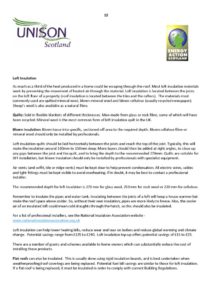
Loft Insulation
As much as a third of the heat produced in a home could be escaping through the roof. Most loft insulation materials work by preventing the movement of heated air through the material. Loft insulation is located between the joists on the loft floor of a property (roof insulation is located between the tiles and the rafters). The materials most commonly used are quilted mineral wool, blown mineral wool and blown cellulose (usually recycled newspaper). Sheep’s wool is also available as a natural fibre.
Quilts: Sold in flexible blankets of different thicknesses. Man-made from glass or rock fibre, some of which will have been recycled. Mineral wool is the most common form of loft insulation quilt in the UK.
Blown insulation: Blown loose into specific, sectioned-off area to the required depth. Blown cellulose fibre or mineral wool should only be installed by professionals.
Loft insulation quilts should be laid horizontally between the joists and reach the top of the joist. Typically, this will make the insulation around 100mm to 150mm deep. More layers should then be added at right angles, to close up any gaps between the joist and the quilt, and to bring the depth to the recommended 270mm. Quilts are suitable for DIY installation, but blown insulation should only be installed by professionals with specialist equipment.
Air vents (and soffit, tile or ridge vents) must be kept clear to help prevent condensation. All electric wires, cables and light fittings must be kept visible to avoid overheating. If in doubt, it may be best to contact a professional installer.
The recommended depth for loft insulation is 270 mm for glass wool, 250 mm for rock wool or 220 mm for cellulose.
Remember to insulate the pipes and water tank. Insulating between the joists of a loft will keep a house warmer but make the roof space above colder. So, without their own insulation, pipes are more likely to freeze. Also, the cooler air of an insulated loft could mean cold draughts through the hatch, so this should also be insulated.
For a list of professional installers, see the National Insulation Association website – www.nationalinsulationassociation.org.uk
Loft insulation can help lower heating bills, reduce wear and tear on boilers and reduce global warming and climate change. Potential savings range from £135 to £240. Loft insulation top-up offers potential savings of £15 to £25.
There are a number of grants and schemes available to home owners which can substantially reduce the cost of installing these products.
Flat roofs can also be insulated. This is usually done using rigid insulation boards, and is best undertaken when weatherproofing/roof coverings are being replaced. Potential fuel bill savings are similar to those for loft insulation. If a flat roof is being replaced, it must be insulated in order to comply with current Building Regulations.
